The amyloid-beta precursor protein is phosphorylated via distinct pathways during differentiation, mitosis, stress, and degeneration
- PMID: 17634293
- PMCID: PMC1995701
- DOI: 10.1091/mbc.e06-07-0625
The amyloid-beta precursor protein is phosphorylated via distinct pathways during differentiation, mitosis, stress, and degeneration
Abstract
Phosphorylation of amyloid-beta precursor protein (APP) at Thr(668) is a normal process linked to neurite extension and anterograde transport of vesicular cargo. By contrast, increased phosphorylation of APP is a pathological trait of Alzheimer's disease. APP is overexpressed in Down's syndrome, a condition that occasionally leads to increased APP phosphorylation, in cultured cells. Whether phosphorylation of APP in normal versus high APP conditions occurs by similar or distinct signaling pathways is not known. Here, we addressed this problem using brainstem-derived neurons (CAD cells). CAD cells that ectopically overexpress APP frequently show features of degenerating neurons. We found that, in degenerating cells, APP is hyperphosphorylated and colocalizes with early endosomes. By contrast, in normal CAD cells, phosphorylated APP (pAPP) is excluded from endosomes, and localizes to the Golgi apparatus and to transport vesicles within the neurites. Whereas the neuritic APP is phosphorylated by c-Jun NH(2)-terminal kinase through a pathway that is modulated by glycogen synthase kinase 3beta, the endosomal pAPP in degenerated CAD cells results from activation of cyclin-dependent kinase 5. Additional signaling pathways, leading to APP phosphorylation, become active during stress and mitosis. We conclude that distinct pathways of APP phosphorylation operate in proliferating, differentiating, stressed, and degenerating neurons.
Figures


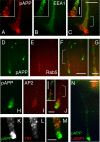
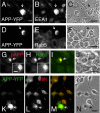
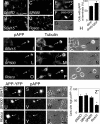
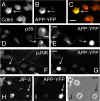
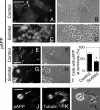

Similar articles
-
c-Jun NH2-terminal kinase-interacting protein-3 facilitates phosphorylation and controls localization of amyloid-beta precursor protein.J Neurosci. 2005 Apr 13;25(15):3741-51. doi: 10.1523/JNEUROSCI.0152-05.2005. J Neurosci. 2005. PMID: 15829626 Free PMC article.
-
Dishevelled regulates the metabolism of amyloid precursor protein via protein kinase C/mitogen-activated protein kinase and c-Jun terminal kinase.J Neurosci. 2001 Jul 15;21(14):4987-95. doi: 10.1523/JNEUROSCI.21-14-04987.2001. J Neurosci. 2001. PMID: 11438574 Free PMC article.
-
Coordinated transport of phosphorylated amyloid-beta precursor protein and c-Jun NH2-terminal kinase-interacting protein-1.J Cell Biol. 2005 Nov 21;171(4):615-25. doi: 10.1083/jcb.200502043. J Cell Biol. 2005. PMID: 16301330 Free PMC article.
-
Impaired autophagy and APP processing in Alzheimer's disease: The potential role of Beclin 1 interactome.Prog Neurobiol. 2013 Jul-Aug;106-107:33-54. doi: 10.1016/j.pneurobio.2013.06.002. Epub 2013 Jul 1. Prog Neurobiol. 2013. PMID: 23827971 Review.
-
Current advances on different kinases involved in tau phosphorylation, and implications in Alzheimer's disease and tauopathies.Curr Alzheimer Res. 2005 Jan;2(1):3-18. doi: 10.2174/1567205052772713. Curr Alzheimer Res. 2005. PMID: 15977985 Review.
Cited by
-
Anti-Inflammatory Effects of GPR55 Agonists and Antagonists in LPS-Treated BV2 Microglial Cells.Pharmaceuticals (Basel). 2024 May 24;17(6):674. doi: 10.3390/ph17060674. Pharmaceuticals (Basel). 2024. PMID: 38931342 Free PMC article.
-
Ryanodine receptor blockade reduces amyloid-β load and memory impairments in Tg2576 mouse model of Alzheimer disease.J Neurosci. 2012 Aug 22;32(34):11820-34. doi: 10.1523/JNEUROSCI.0875-12.2012. J Neurosci. 2012. PMID: 22915123 Free PMC article.
-
Phosphorylation Signaling in APP Processing in Alzheimer's Disease.Int J Mol Sci. 2019 Dec 27;21(1):209. doi: 10.3390/ijms21010209. Int J Mol Sci. 2019. PMID: 31892243 Free PMC article. Review.
-
Role of methylglyoxal in Alzheimer's disease.Biomed Res Int. 2014;2014:238485. doi: 10.1155/2014/238485. Epub 2014 Mar 9. Biomed Res Int. 2014. PMID: 24734229 Free PMC article. Review.
-
Is abnormal axonal transport a cause, a contributing factor or a consequence of the neuronal pathology in Alzheimer's disease?Future Neurol. 2009 Nov 1;4(6):761-773. doi: 10.2217/fnl.09.54. Future Neurol. 2009. PMID: 20076770 Free PMC article.
References
-
- Aplin A. E., Gibb G. M., Jacobsen J. S., Gallo J. M., Anderton B. H. In vitro phosphorylation of the cytoplasmic domain of the amyloid precursor protein by glycogen synthase kinase-3beta. J. Neurochem. 1996;67:699–707. - PubMed
-
- Ball C. L., Hunt S. P., Robinson M. S. Expression and localization of alpha-adaptin isoforms. J. Cell Sci. 1995;108:2865–2875. - PubMed
Publication types
MeSH terms
Substances
Grants and funding
LinkOut - more resources
Full Text Sources
Miscellaneous

